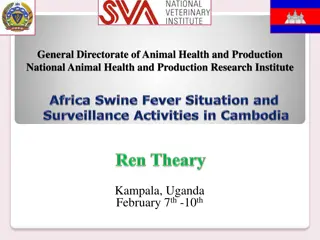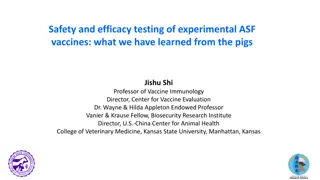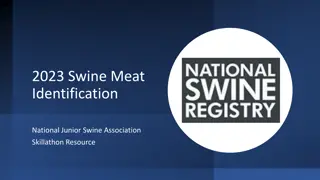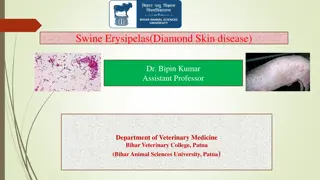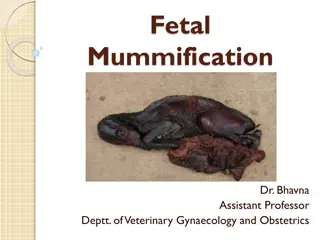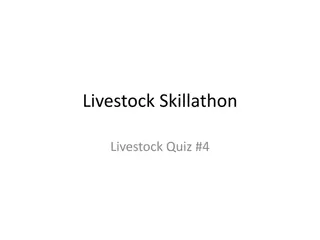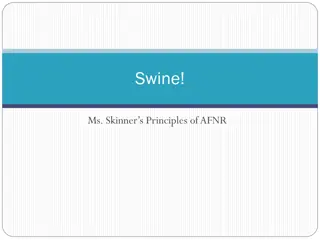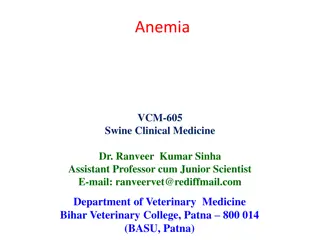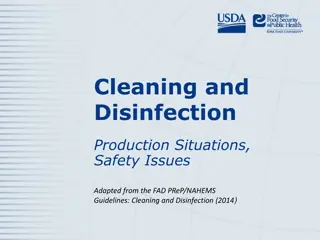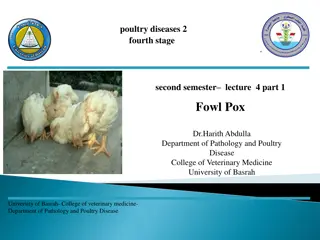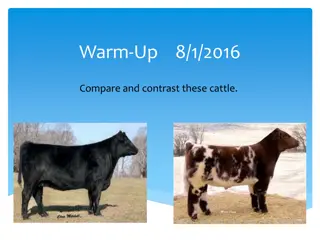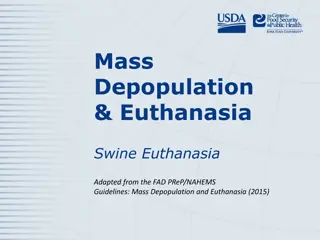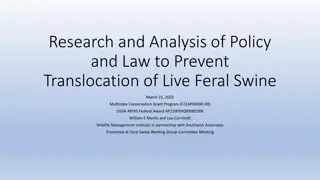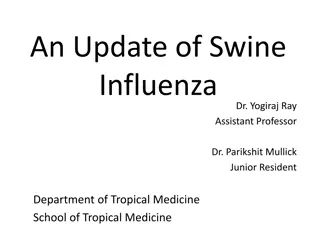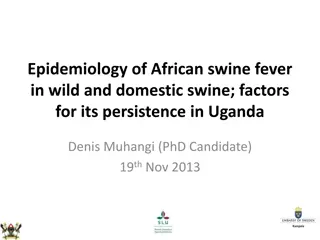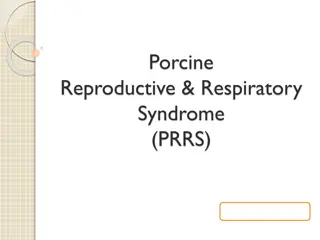Understanding Mycoplasmosis in Swine
Mycoplasmosis in swine is caused by Mycoplasma species, with Mycoplasma hyopneumoniae as the most common. It leads to chronic bronchopneumonia and can suppress the immune system, allowing other bacteria to proliferate in the lungs. The disease is characterized by slow growth in culture, adhesion to airway epithelium, and immunosuppressive effects. Colonization, pathogenesis, and colony morphology play important roles in the progression of the disease.
Download Presentation

Please find below an Image/Link to download the presentation.
The content on the website is provided AS IS for your information and personal use only. It may not be sold, licensed, or shared on other websites without obtaining consent from the author. Download presentation by click this link. If you encounter any issues during the download, it is possible that the publisher has removed the file from their server.
E N D
Presentation Transcript
Classification Division: Prokaryota Class: Mollicutes Order: Mycoplasmatales Family: Mycoplasmataceae Genus: Mycoplasma Species (most common) : M. hyopneumoniae, M. hyorhinis, M. hyosynoviae, M. suis Other species: M. flocculare, M. sualvi, M. hyopharyngis, M. arginii, M. bovigenitalium, M. buccale, M. gallinarum, M. iners, M. mycoides, M. salivarium
Mollicutes No cell wall Plants, animals, humans Low Gram +, small genomes, no biosynthetic pathways -> amino pyrimidines, and membrane components from growth environment acids, purines,
Mycoplasma Hyopneumoniae initiates a chronic insidious bronchopneumonia known as enzootic pneumonia by suppression of innate and acquired allowing upper respiratory commensal bacteria to proliferate in the lungs and contribute to disease pulmonary immunity
Colony morphology In culture, Mhyo grows slowly -> turbidity and an acid color shift to the media 3-30 days after inoculation of media Inoculation of solid agar medium and incubation in a 5-10% carbon dioxide atmosphere-> visible colonies after 2-3 days of incubation Strains are antigenically and genetically diverse NO variable surface proteins -> varies it through varies proteolytic events -> altered immunoblot protein patterns
Pathogenesis Colonization of airway epithelium Stimulation of a prolonged inflammatory reaction Suppression and modulation of innate and adaptive immune responses Interaction with other infectious agents
Pathogenesis 1) Colonization: binding to the cilia of epithelial cells in the airways Adhesion: P97 Colonization results in ciliostasis, clumping and loss of cilia, and loss of bronchial epithelial and goblet cells Reduction in the efficency of clearance of debris and invading mucociliary apparatus. pathogens by the
Pathogenesis IMMUNOSUPPRESSIVE respiratory commensal bacteria are able to establish and proliferate in the alveoli as SECONDARY PATHOGENS! ENZOOTIC PNEUMONIA Virulence factor remain unknown EFFECTS upper
Pathogenesis The innate and adaptive respiratory immune response are also modulate colonization of airways pulmonary inflammatory response. Colonization of cilia Infiltration of peribronchiolar and adjacent perivascular connective MACROPHAGES and lymphocytes chronic prolonged and tissue B by both and T
Pathogenesis Mhyo produce proinflammatory cytokines IL-1, IL-6, IL-8 and tumor necrosis factor- , IL- 10, IL-12, IL-18 (its secretion of interferon- is inhibited) DOWNREGULATION IMMUNITY! Stimulation of the inflammation which causes tissue injuries in the lungs infection induces macrophages to OF CELLMEDIATE
Transmission Direct trasmission through nose to nose contact Airborne transmission Vertical transmission (from sow to pig and then between littermate or penmates)
Signs All ages Incubation period is unpredictable, it spreads slowly, clinical disease begins at 2-6 months Morbidity 100% EPIDEMIC FORM Spreads rapidly Coughing, acute respiratory distress, pyrexia, death
Signs ENDEMIC FORM Transition in 2-5 months Dry, nonproductive cough (2-3 weeks or persists) Fever, decreased appetite, labored breathing or prostration due to secondary pathogens Pigs will appear fairly healty, but we will have greater dispersion in size if we reduced feed intake
Gross lesions Acute epidemic respiratory mycoplasmosis: Cranial ventral or diffuses increased firmness, failure to collapse, marked edema of the lungs. Chronically affected enzootic pneumonia: Purple to gray rubbery consolidation of the cranial ventral portions of the lungs in a lobular pattern
Gross lesions Uncomplicated infection: Lesion of smaller portion of the lungs and on cut surface, parenchyma uniform in color, catarrhal exudate from airways Enzootic pneumonia+ secondary pathogens: Lager portions of the lungs is are affected, more firm and heavy, on cut surface are mottled by aroborized clusters of gray to white exudate distended alveoli, mucopurulent exudate from airways
Gross lesions Chronic recovered lesions: Thickeness by firm white connective tissue of interlobular connective tissue in the cranial ventral lungs Tracheobronchial lymph nodes are firm, moist and enlarged
Microscopic lesions Lymphocytes and fewer macrophages form cuffs around the airways, and adjacent blood vessels and lymphocytes propriasubmucosa of the airways Epithelium of the airways may be hyperplastic Serous fluid and fluid distended macrophages, fewer neutrophils, lymphocytes, plasma cells in alveoli and airway lumens expand the
Microscopic lesions Chronic lesions: Lymphocytic cuffs are more prominent and contain lumphoid nodules Increased numbers hyperplasia of submucosal glands in bronchi Enzootic pneumonia: Exudate in alveoli and airway lumens is more extensive and may contain dense aggregates of secondary bacteria Recovering lesions: Collapsed and/or emphysematous alveoli of globet cells and
Diagnosis Herd epidemiology Culture grosslyairway (4-8 weeks to grow) Flourescent immunohistochemistry hybridization (ISH) on tissue collected as soon after death and fixed in 10% NBF (IHC and ISH)or chilled and shipped on ice within 24 h (FA) on samples of lungs with antibody (FA) or or (IHC) in situ
Diagnosis PCR on lung tissue, bronchial swabs, or bronchial washings Real-time PCR Serology (positive or negative status)
Treatment Antibiotics: quinolones, tylosin, oxytetracycline, tilmicosin, and tulathromycin Other: tiamulin, danfloxacin, chlortetracycline, lincomycin, tilmicosin Little efficacy: polymyxin, streptomycin, trimethoprim, sulfonamides NO: penicillin, ampicillin, cephalosporin (they interfere with cell wall) Resistance to: tetracyclines, lincosamides, flouruquinolones erythromicin, amoxicillin, macrolides, OFTEN WE NEED TO USE MULTIPLE ANTIBIOTICS TO CONTROL THE SECONDARY PATHOGENS TOO!
Prevention Providing ventilation, temperature, number of animals, space) Strategy of control: all in- all out pig flow, medicated and segregated early weaning Eradication: treat the sows with antibiotics and the pigs weaned at 6 days of age, and segregated early weaning with the use of multisite operation an optimal environment (air,
Prevention Using deprived pigs to repopulate a herd Vaccines: to control the clinical disease associated with mycoplasma pneumonia. NOT PREVENT Single or dual dose + antibiotics: to reduce clinical disease Sow vaccination is controversial pigs cesarean-derived, colostrum-
Mycoplasma Hyorhinis is the agent that causes polyserositis, arthritis, and otitis. The organism is ubiquitous within the swine population
Pathogenesis It adheres to ciliated epithelial cells within the upper and lower respiratory tract of pigs (=Mhyo) Presence in the eustachian tube Other pathogens and stress may facilitate the spread Once systemic polyarthritis in pigs less than 8 weeks arthritis in pigs of 3-6 months polyserositis and
Signs Polyserositis occurs in 3-10 weeks old pigs Signs at 3-10 days PI: roughened hair coat, slight fever, depression, reduced appetite, reluctance to move, difficulty breathing, abdominal tenderness, lameness and swollen joints Acute signs: resolve after 10-14 days Arthritis lameness and swollen joints for 2-3 months, up to 6 months
Signs Mhr pneumonia Clinical signs are uncommon: dry nonproductive cough indistinguishable from Mhyo Otitis Head tilt Conjunctivitis Reddening of the conjunctiva, crustin of the margins of lids by exudate and tearing
Gross lesions Septicemic Mhr Fibrinopurulent peritonitis. Affected serosal membranes are thickened, cloudy and rough, with fibrous adhesions Joints are swollen with serosanguinous and fibrinous synovial fluid. Synovial membranes are swollen and hyperemic. Pannus, erosion of articular cartilage and fibrous adhesions. pericarditis, pleuritis and
Gross lesions Lesion in the lungs are the same of Mhyo but milder Otitis Appearance of mycoplasmas among the cilia in the auditory canal and middle ear, and purulent exudate fill the middle ear
Diagnosis Slinical signs and gross lesions Culture or molecular methods on samples from untreated animals subacute clinical signs (swab of serosal surface or joints with typical exudate or fibrin from these locations) PCR with acute or
Treatment and prevention Tylosin or lincomycin Preventin conditions that may predispose the animal NO VACCINE
Mycoplasma Hyosynoviae Cause of arthritis Mhs colonizes the respiratory tract of pigs and is located in the upper portions. The organism can persist in carrier swine indefinitely in the tonsils In infected sow the TRANSMITTED TO PIGS UNTIL 4-8 weeks age organism IS NOT
Pathogenesis Acute phase lasts 1-2 weeks (the organism sprea to the joints and tissues throughout the body) and occurs after 1-2 weeks from the lameness and typically 2-3 weeks PI Incubation period of arthritis: 4-9 day PI Subacute and chronic phase 3-16 weeks after clinical arthritis Tonsils and lympho nodes remain infected
Signs Acutely lameness (3-5 month-old pigs) Normal rectal temperature. Slight reduction in appetite that laid to weight loss Joints normal or swollen, soft and fluctuating Acute sign lasts 3-10 days Low mortality, 1-50% morbility
Gross lesions Proliferation, swelling, edema, and hyperemia of synovial membranes in infected joints Small amount of fibrinous or fibrinopurulent exudate may coat synovial membranes Increased volume of synovial fluid (serofibrinous, serosanguinous or cloudy and brownish) Edema of periarticular tissues surrounding the affected joints In chronic phases: joints membranes may be thickened by fibrosis
Microscopic lesions Acute lesion in synovial membranes with edema, hyperemia, hyperplasia of synovial cells, and perivascular lymphocytes, plasma cells and macrophages infiltration with
Diagnosis Culture or PCR on joint fluid or synovial membranes aseptically affected joints in acutely lame untreated animals Serology: complement fixation assay and ELISA on serum samples collected during the acute and subacute or chronic phase collected from
Treatment Enrofloxacin, tiamulin Mhs is sensitive to tylosin, lincomycin and valnemulin NO VACCINE lincomycin, tetracycline and
Mycoplasma suis causes anemia in pigs Originally anaplasmosis-like icteroanemia, respiratory distress, weakness, and fever occurring in 2-8 month-old pigs. observed as a rickettsia-like characterized or by disease In 1950- E.suis: described as two species (E.suis and Eperythrozoon parvum), it was later determined that they are the same organism at different stages of maturity.
Etiology Lack of intracellular parasitism, small size, lack of cell wall, susceptibility to tetracyclines Round to oval, 0.2-2 m that adheres to the surface of erythrocyte membranes and invade it, residing in membran-bound vacuoles or free in the cytoplasm
Epidemiology Morbidity 10-60%, mortality ou to 90% in acute disease Transmission: Direct expose by oral uptake of blood and blood components Living vectors (ectoparasites and insects) Non living vectors (needles, surgical instrument etc) By semen, only if there is blood contamination (rare) Vertical transmission in utero
Pathogenesis Experimentally incubation period: 3-10 days natural incubation period is variable. Status of carrier is also possible Acute phase Heavy bacteriemia severe anemia (decrease inpacked cell volume, totale red blood cells count, and hemogliobin concentration is due to MASSIVE PARASITISM OF RBCs) RBCs with altered membranes are recognized ad abnormal and removed from the circulation by the spleen Increased bleeding potential coagulopathy Hypoglycemia and blood acidosis GENERAL IMMUNOSUPPRESSION consumptive
Signs Acute hemolytic disease and death in young pigs, prepartum sows, and stressed weaned and feeder pigs In sows: fever, anorexia, lethargy, decreased milk production, poor maternal behavior. Clinical signs occur within 3-4 days of introduction to the immediatly after farrowing farrowing room or
Signs Pallor, fever, icterus, cyanosis of the extremities (ears) Mild anemia and poor growth rates in weaned and feeder pigs Chronic infection in animals with parasites: unthriftiness, pallor, and skin hypersensitivity (urticaria) Decreased reproductive efficiency evidenced by sows with anestrus, embryonic death and abortion delayed estrus, early
Diagnosis Clinical signs and gematology results Splenectomize a potentially infected pig or inoculate a splenectomized pig with blood from suspected pigs PCR Complement fixation Indirect hemagglutination ELISA Real-time PCR
Treatment Oxytetracycline, 20-30 mg/kg parenterally Administration of oxytetracycline at time of stress can prevent acute disease. Oral therapy can reduce the incidence of anemia. NOT PREVENT OUTBREAKS Supportive therapy Iron dextran injections (200 mg/pig) help recovery and minimize mortality
Prevention Supportive therapy Preventin reinfection Parasitic needles etc) NO VACCINE Control of animal movement (negative status ca be assumed if serologica or PCR tests from serum of pigs in the farrowing unit are negative or if transfusion fro at least 10 blood samples into slenectomized pigs has no effect) control and hygiene (changing
Bibliography Jeffrey J zimmerman, Locke A Karriker, Alejandro Ramirez, Kent J Schwartz, Gregory W Stevenson, Disease of Swine, 10 edition 2012


